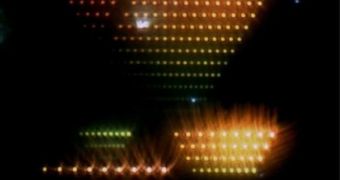Radio signals have been the standard for data transmission for well over a century, and innovations in the field have meant that higher and higher frequencies have been used to get as much data across as possible. Some time ago, scientists found out that wavelengths belonging to visible light could also be used for high-speed data transfer, and then research was underway to make such a means of communication possible. However, designing the small antennas needed for such forms of data transmission proved to be extremely expensive and difficult to accomplish. Now, experts at the KIT Light Technology Institute (LTI) managed to devise a method that could see them produced cheaply.
For radio transmissions, a dipole antenna on the sending and receiving sides is all that it takes to transmit data from point A to point B. The best reception is ensured when the length of the antenna is about half the wavelength of the electromagnetic wave that it's supposed to detect. In more recent times, radio signals have been made to operate at very high frequencies, so the length of the antenna had to get considerably shorter. Currently, plans are to move to the 500,000-GHz range, which is equivalent to about 350 nanometers, in yellow light wavelengths.
Creating optical transmission antennas at the nanoscale is tremendously difficult to accomplish. The KIT team was, however, able to move past this obstacle, when it created gold nanoantennas smaller than 100 nanometers in size. Because conventional production methods could not be applied, the team, based at the KIT “Nanoscale Science” DFG-Heisenberg Group, used a method known as electron beam lithography to create the antennas. Details of the amazing achievement can be found in the latest issue of the respected scientific journal Nanotechnology, ScienceDaily reports.
Because the new antennas are up to ten million times smaller than conventional ones, they can receive frequencies that are up to one million times higher than the ones regular radio antennas are capable of receiving. This means that, rather than working in the 100-MHz range, the new signals would operate in the 100,000-GHz frequency range. This amazingly high frequency allows for an extremely rapid modulation of the signal, which means that it will be able to travel at very high speeds between receivers, and also that it will carry a lot more information than existing ones.

 14 DAY TRIAL //
14 DAY TRIAL //